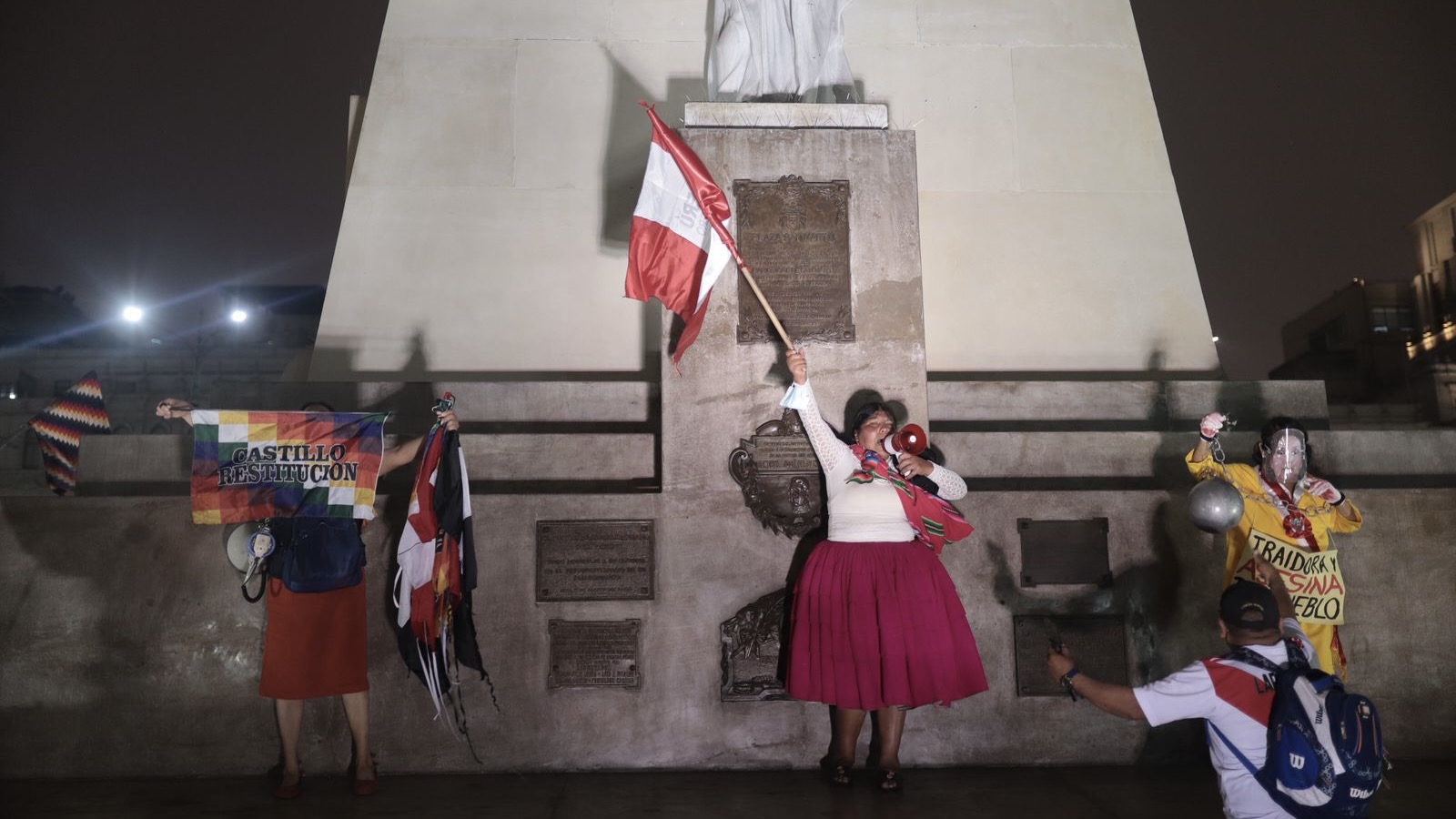On Saturday, July 22, thousands of Peruvians once again hit the streets of the capital Lima to demand the resignation of de-facto president Dina Boluarte, the closure of right-wing dominated Congress, new general elections, a constituent assembly to write a new constitution, justice for the victims of state repression during the protests between December 2022 and February 2023.
Saturday’s protest is part of renewed national efforts to intensify the struggle against the Boluarte government which began on July 19 with the “third takeover of Lima” mobilization. Dozens of delegations of Indigenous peoples, peasant communities, social organizations and trade unions have traveled to Peru’s capital, Lima, to participate in the protests which will continue across the country until July 28, Peruvian Independence Day.
On Saturday, protesters marched peacefully from Dos de Mayo square to San Martín square. When they reached the San Martín square, agents of the Peruvian National Police (PNP) began to repress them. The Police used an indiscriminate amount of tear gas to disperse the crowd. The officers forcibly removed people from the plaza, aggressively pushing both men and women of all ages. They even tried to pull young protesters’ gas masks and safety glasses, and prevented the press from recording what was happening.
“The police have attacked us…But they won’t stop us. Only the people can put an end to this dictatorship,” said the woman from the Aymara Indigenous community who was pushed from some steps by police officers at the San Martín square.
Through social media networks, human rights organizations reported that during the repression, a member of the health brigades, groups clearly identified with a red cross that attend to injured protesters, was injured. The organizations also reported that three protesters were arrested after minor scuffles with police.
The National Human Rights Coordinator of Peru (CNDDHH), whose members observe social protests and document human rights violations, publicly condemned that undercover police officers were detected participating in arrests. The organization reminded that “according to the IACHR and the UN, all police officers must be identified during protests,” stressing that “anonymity favors abuse and impunity.”
The CNDDHH also denounced that in recent protests, three of its observers had suffered attacks by members of the PNP and had been defamed as “terrorists,” while carrying out their work of accompanying, registering and denouncing violations of human rights. The organization rejected all acts of repression and hate speech.
📽️VIVO. En este momento, la movilización sale de la Plaza 2 de Mayo. La ciudadanía marcha pacíficamente. Seguiremos acompañado la movilización.#22Julio
#DerechoALaProtesta#CNDDHH pic.twitter.com/c2N547ChKM— CNDDHH 🇵🇪 #NiUnMuertoMás (@cnddhh) July 22, 2023
🔴 URGENTE
La movilización llegó pacíficamente a la Plaza San Martin, pero la @PoliciaPeru comenzó a reprimir innecesariamente.
Exigimos alto a la represión#CNDDHH pic.twitter.com/xWmjujhOYS— CNDDHH 🇵🇪 #NiUnMuertoMás (@cnddhh) July 22, 2023
According to reports from local media and human rights organizations, an estimated 70 people were killed in violent repression by state security forces in the first three months of the anti-coup protests. The IACHR, in its report released in May, slammed the Peruvian authorities for responding to the demonstrators with “disproportionate, indiscriminate and lethal use of force,” classifying the actions by state forces as “extrajudicial executions” and “massacres.”
During the recent protests, the demonstrators have been chanted the popular chants such as “Dina asesina, el pueblo te repudia [Dina murderer, the people repudiate you],” or “Dina y el Congreso, la misma porquería [Dina and the Congress, the same crap],” fiercely expressing their discontent with her regime and the conservative-majority parliament.
The call for the march was given by the National Unitary Coordinator of Struggle, a platform that brings together various social organizations from across the national territory, a day after the massive Third Takeover of Lima march. According to the platform, peaceful marches will continue in Lima and other parts of the country until July 28, the Peruvian Independence Day.
Boluarte, who took office after democratically elected left-wing President Pedro Castillo was removed in a legislative coup and subsequently arrested in December 2022, has been highly unpopular since the day she assumed power. She has been criticized by the people for joining a political alliance with the country’s right-wing forces to govern.
According to a new survey conducted by the Institute of Peruvian Studies (IEP), the disapproval rating of Boluarte has risen from 71% in January to 81.6% in July, while that of the Congress has increased from 89% to 90.4%. With respect to the demands raised at protests, the poll showed that 75% of those consulted were in favor of Boluarte’s resignation, 74% were in favor of the closure of the current Congress, and 69% in favor of creating a constituent assembly to change the current Constitution, which was written and imposed in 1993 under the far-right dictatorship of Alberto Fujimori (July 1990–November 2000). The poll also showed that 58% of the people identify themselves with the ongoing protests. The study also showed that 49% of the people believed that Peru is not a democracy, and that 80% were in favor of holding elections before 2026.
Enver León, secretary general of the left political party Nuevo Peru, commented on the polls findings and said, “The resignation of DinaAsesina (Dina killer) and the closing of the corrupt congress is a growing national cry, the expression of 19J (July 19) wherein Lima joined [the mobilizations] with force scares the ruling class and their henchmen of the media. But important to point out, the Constituent Assembly continues to be a way out of the crisis.”





